Background
Stream maintenance helps achieve Sonoma Water's Vision for Our Creeks. Sonoma Water owns, or has easements to maintain hydraulic capacity, on approximately 75 miles of engineered flood control channels. The channels are primarily located in the vicinity of Santa Rosa, Rohnert Park, Cotati, Petaluma, and Sonoma. Sonoma Water also has easements to maintain hydraulic capacity over approximately 100 miles of modified or natural channels.
Below are maps of the streams in each flood zone where Sonoma Water has maintenance authority.
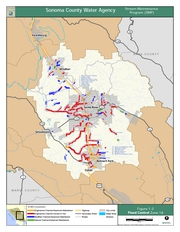 | |||
2024 Stream Maintenance Program
Each summer, Sonoma Water works in and around streams throughout Sonoma County, managing creekside plants, removing sediment and garbage and planting trees. Riparian canopies – mature trees surrounding a stream – provide shade, which helps cool the water and shade out less desirable plant species.
View the Stream Maintenance Brochure
Stream maintenance activities support a proactive regional approach to flood protection and stream and wildlife habitat restoration.
2024 Stream Maintenance Public Notice (PDF)– printed in the June 9, 2024 Sunday issue of the Press Democrat.
 (002).png?width=768)
Previous years stream maintenance activities
- Previous years vegetation management locations
- Previous years sediment removal and bank stabilization projects
Stream Maintenance Program Manual
The Stream Maintenance Program (SMP) was developed by Sonoma Water to improve and define the management and maintenance of flood control channels and streams under Sonoma Water's authority. The SMP Manual establishes and defines the overall maintenance program and describe the program’s maintenance activities, natural resources, and approaches to avoid or minimize impacts to environmental resources. The SMP also provides the organizational framework to oversee routine channel maintenance activities and ensure the program is compliant with the terms and conditions of its permits. The SMP was developed to be consistent with Sonoma Water's mission and vision statements and is intended for use by Sonoma Water maintenance staff, engineers, and resource managers, as well as environmental regulatory agency staff and other watershed stakeholders.
- 2020 Stream Maintenance Program Manual (32MB)
- 2020 Stream Maintenance Program Manual - Appendices (79MB)
- Addendum: Appendix G: Sediment Sampling and Analysis Guidelines (Monitoring and Reporting Program) for Zones 2A and 3A (.1MB)
Evolution of maintenance approach
Since the initial flood management programs of the 1950s, routine maintenance needs have continued to be assessed and prioritized through seasonal and annual inspections with various sediment removal, bank stabilization, and vegetation management activities prioritized as necessary following inspections. The mandate and requirement for routine annual maintenance to provide adequate flood protection has not wavered since the construction of the stream and channel facilities. However, Sonoma Water's perspective towards stream management has evolved and now includes multiple objectives such as resource protection and environmental sustainability in addition to flood management.
Additionally, local, state, and federal regulations and their requirements have also changed over time. Compliance with federal laws and regulations such as the Endangered Species Act (ESA) and Clean Water Act (CWA) as well as state laws and regulations administered by the Department of Fish and Game and Regional Water Quality Control Board require an extensive authorization process each year for Sonoma Water’s planned activities.
Vision for Our Creeks
Sonoma Water is working to help our creeks evolve into waterways that not only provide good flood protection, but also provide good riparian habitat and water quality.
The Vision for Our Creeks is mature riparian canopy, with alders and other trees that grow tall and stretch their branches over the creek, cooling the water and shading out bushes, brush and less desirable species of trees that reduce the water-carrying capacity of the creek.
This transition will take time. By selectively thinning brush and willows and planting canopy-forming trees on stream banks, we can encourage and monitor the progress toward a mature riparian canopy, while maximizing the flood protection provided by the creek.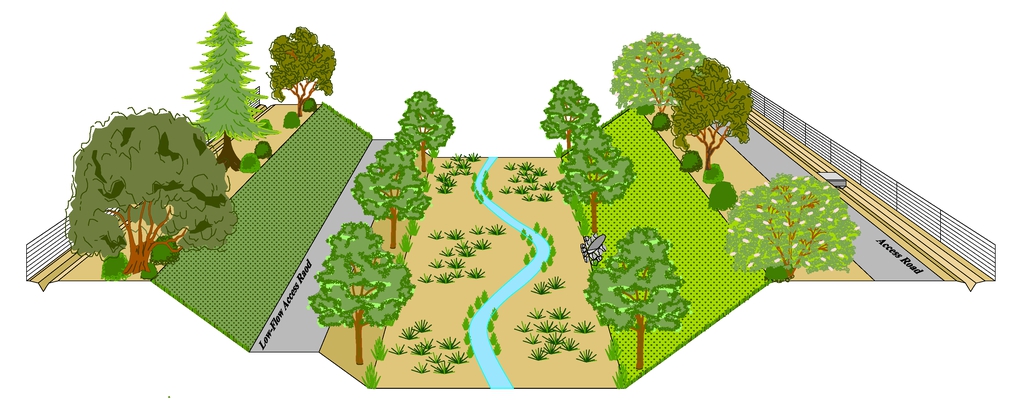
Routine maintenance activities in engineered and modified channels
Sediment Management
Sediment management refers to the removal of excess sediment from engineered flood channels and engineered portions of modified channels (culverts). Sediment management activities are generally conducted from June 15th to October 15th when streams are typically at their driest. The number of sediment removal projects undertaken and the quantity of sediment removed in a given year depend on the frequency and extent of past maintenance activities, as well as weather and hydrologic conditions during recent years. Sediment management needs following a wet winter with higher than usual runoff, slope erosion, and sediment delivery to (and transport within) the engineered channel system will likely be greater than maintenance requirements following an average or dry winter.
Sonoma Water's preferred approach for sediment removal projects is to use the least environmentally damaging approach that is reasonable, not prohibitive in cost, and time-efficient. Sonoma Water looks for opportunities to improve channel structure and install a system that is self-sustaining and will require less maintenance in the future. One common design feature is the installation of a low-flow channel. This type of design helps transport sediment through the system instead of allowing it to settle out and build up in the channel, thereby reducing the need for regular sediment removal, and correspondingly, cattail removal. In addition, low-flow channels are beneficial because they provide deeper water habitats that tend to stay cooler in summer and provide better habitat to aquatic species. Sonoma Water also considers appropriate locations to target sediment deposition and develop in-channel sediment basins to ease channel access and reduce channel access impacts.
Bank Stabilization
Sonoma Water performs repairs of eroding banks as a routine maintenance within the engineered channels where it has maintenance authority. Bank stabilization involves the repair and stabilization of eroded or eroding stream or reservoir banks. Destabilized banks that are not repaired will continue to erode and shed sediment into the channel.
Sonoma Water’s approach for stabilizing banks includes minimizing hardscape by back-filling with soil, installing erosion control fabric, seeding with grasses and planting of native riparian trees to provide additional bank stability and increase canopy in the channel.
Vegetation Management
Vegetation management in engineered channels is organized according to the type of activity. The degree of vegetation management performed depends on local reach conditions, neighboring land uses, and existing channel conveyance capacity. Vegetation management activities include: willow pruning and removal; blackberry removal; cattail removal; ludgwigia removal; tree pruning and exotics removal; mowing; and nursery stock tree planting. Vegetation management activities are overseen by a biologist, certified arborist, or other qualified personnel.
The activities are completed with the goal of transitioning the streams into waterways that not only provide flood protection, but also provide good riparian habitat and water quality. The goal is a mature riparian canopy with alders, maples, and other trees that grow tall and stretch their branches over the creek. Over the long-term, the establishment of a mature riparian canopy is expected to reduce the level of routine maintenance that is required. This will be completed over several years by selectively thinning and brush and multi-trunk tree species and planting single-trunk, canopy forming trees on stream banks.
Other Maintenance Activities include:
- Access Road Maintenance
- V-Ditch Maintenance
- Culvert Repair and Installation
- Debris Removal
- Fence Maintenance
- Graffiti Removal
Maintenance activities in modified and natural channels
Maintenance work conducted in modified and natural channels (where Sonoma Water has a hydraulic easement) is generally limited to the removal of debris or vegetation that block flows and could significantly increase the potential for flooding. Sonoma Water is not obligated to perform maintenance in modified or natural channels.
This work is conducted on an as needed basis and usually occurs as a result of notification of a problem by an adjacent landowner or public entity. In general, this type of work is performed relatively infrequently (15–20 times each year). The most common type of work conducted in these channels is the removal of blackberry thickets or fallen trees that significantly increase the potential for flood damage to structures. Trash or vegetation debris may also cause a blockage and require removal. Periodically, sediment removal may be required in engineered portions of modified channels (culverts).
Frequently Asked Questions
Why maintain streams?
Stream maintenance activity is primarily for flood protection. By managing vegetation in the waterway, we can retain the water-carrying capacity of the channel, thereby maintaining protection against floods. However, when we consider removing vegetation, we must also consider its habitat value to fish and wildlife. Trees, in particular, provide protection for fish while also shading the water, which helps to keep the temperature cool. So planning and performing stream maintenance requires a careful balance of flood protection and environmental protection. All of the stream maintenance activities we perform are permitted by both the Regional Water Quality Control Board and the California Department of Fish and Game.
When do stream maintenance activities begin?
The allowable window for performing stream maintenance is actually very small. We can't start work until the site is free of nesting birds, and all activities in the stream channels must be complete by Oct. 15, before the rainy season. So we must work quickly once our biologists determine that the nesting is complete.
How do we choose the sites to maintain?
Each year Sonoma Water performs an inventory, including flow models, and compare each site's estimated water-carrying capacity against its design capacity. Based on the results, we prioritize approximately ten miles of stream each summer for maintenance.
Contact Information:
For information about the Stream Maintenance Program or to request maintenance on one of our streams, please contact Jon Niehaus at 707.521.1845.

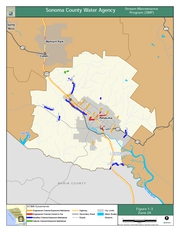

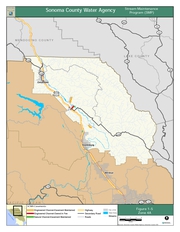

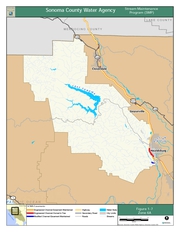
.png?width=180)